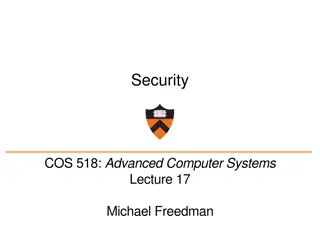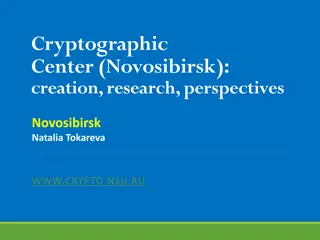Efficient Verified Cryptography in F* by Jean-Karim Zinzindohou
Explore the importance of cryptography verification in F* through Jean-Karim Zinzindohou's joint work with Karthik Bhargavan. Discover the significance of verifying crypto, static guarantees provided, and examples like elliptic curve cryptography. Delve into F* as a rich ML-like language for secure cryptography with a focus on memory safety, side channel mitigation, and functional correctness.
Download Presentation

Please find below an Image/Link to download the presentation.
The content on the website is provided AS IS for your information and personal use only. It may not be sold, licensed, or shared on other websites without obtaining consent from the author. Download presentation by click this link. If you encounter any issues during the download, it is possible that the publisher has removed the file from their server.
E N D
Presentation Transcript
Efficient, verified cryptography in F* Jean-Karim ZINZINDOHOUE Joint work with Karthik BHARGAVAN
1 - Context 20/09/2024 Verifying crypto in F*, J.K. Zinzindohou 2
Why is cryptography verification important ? OpenSSL s poly1305 code 9/20/2024 Verifying crypto in F*, J.K. Zinzindohou 3
Why is cryptography verification important ? Testing is not sufficient to catch overflow bugs OpenSSL s example: too low probability, yet may be exploitable by attackers 2014 s HeartBleed: need of memory safety Side channel mitigation ECDH Key-Extraction via Low-Bandwidth Electromagnetic Attacks on PCs by Genkin, Pachmanov, Pipman & Tromer 9/20/2024 Verifying crypto in F*, J.K. Zinzindohou 4
So what can we prove ? We aim at statically providing guarantees for: Side channel mitigation Preventing execution paths to depend on secret values Memory safety and absence of overflows E.g. no array accesses out-of-bounds, no overflows Functional correctness My code can never go wrong 20/09/2024 Verifying crypto in F*, J.K. Zinzindohou 5
2 Example: elliptic curve verification 20/09/2024 Verifying crypto in F*, J.K. Zinzindohou 6
Elliptic curve cryptography Weierstrass equation: ?,? ?2, ?2= ?3+ ?? + ? In cryptography ? is a finite field (e.g. Z/pZ with p a large prime) Defines a group structure with an additive law kP = P+ +P hard to inverse 20/09/2024 Verifying crypto in F*, J.K. Zinzindohou 7
A short intro on F* ML-like language Functional, no object oriented features Rich type system Refinement types, dependent types, indexes types etc. Customizable lattice of monads Verification automation via SMT-solver Erasure to OCaml/F# Soon compilation to Javascript, C++ Compilation to C for a restricted subset 9/20/2024 Verifying crypto in F*, J.K. Zinzindohou 8
Verification approach Advantages Expressive language Simple but precise functional correctness theorems All-in-one proof Modular, extensible proofs Portable verified code OCaml, F#, C Soon: C++, javascript Drawbacks Not as efficient as hand- tuned assembly Proving the correctness of the different backends is work in progress 20/09/2024 Verifying crypto in F*, J.K. Zinzindohou 9
2.1 Side channel mitigation 20/09/2024 Verifying crypto in F*, J.K. Zinzindohou 10
Side channel mitigation Target: low-level code for cryptographic primitives Manipulated data-structures: Sensitive data : integers, buffers of integers Public values: integers (counters, lengths, indexes etc.) Timing attacks: execution must NOT depend on secret values 20/09/2024 Verifying crypto in F*, J.K. Zinzindohou 11
Side channel mitigation Idea: encode secret values as an F* abstract type new type sint The ghost function v provides mathematical value of an sint: val v: sint -> GTot int val zero: z:sint{v z = 0} The indexed type usint n encodes unsigned machine integers of n bits type usint (n:nat) = x:sint{v x >= 0 /\ v x < pow2 n} 20/09/2024 Verifying crypto in F*, J.K. Zinzindohou 12
Side channel mitigation All computationally relevant functions take an sint as input return an sint: Standard arithmetic ( + , * , % , etc.) Bitwise operations ( & , ^ , << , etc.) Cast, of_int, of_string, etc. Comparison only via masking E.g.: uint32 gte(uint32 a, uint32 b) { return (uint32) ~(((int64_t)a b) >> 63); } 20/09/2024 Verifying crypto in F*, J.K. Zinzindohou 13
Side channel mitigation Consequence: No going from sint to a native F* type Unless in the Ghost effect Impossible to branch on a comparison of sint (either with pattern matching or if-then-else) Branching only on public values Impossible to use the value of an sint to access an array cell Impossible to use precomputed tables as input for instance 20/09/2024 Verifying crypto in F*, J.K. Zinzindohou 14
2.2 Memory safety and integer overflow 20/09/2024 Verifying crypto in F*, J.K. Zinzindohou 15
Memory safety and integer overflow sint are abstract: all operations are defined in the Sint module One can chose her definition of the addition: val uadd_1: #n:nat -> a:usint n -> b:usint n{v a + v b < pow2 n} -> Tot (c:usint n{v c = v a + v b}) val uadd_2: #n:nat -> a:usint n -> b:usint n -> Tot (c:usint n{v c = (v a + v b) % (pow2 n)}) val uadd_3: #n:nat -> a:usint n -> b:usint n -> Tot (c:usint n{v a + v b < pow2 n ==> v c = v a + v b}) 20/09/2024 Verifying crypto in F*, J.K. Zinzindohou 16
Memory safety and integer overflow sint are abstract: all operations are defined in the Sint module One can chose her definition of the addition: val uadd_1: #n:nat -> a:usint n -> b:usint n{v a + v b < pow2 n} -> Tot (c:usint n{v c = v a + v b}) val uadd_2: #n:nat -> a:usint n -> b:usint n -> Tot (c:usint n{v c = (v a + v b) % (pow2 n)}) val uadd_3: #n:nat -> a:usint n -> b:usint n -> Tot (c:usint n{v a + v b < pow2 n ==> v c = v a + v b}) 20/09/2024 Verifying crypto in F*, J.K. Zinzindohou 17
Memory safety and integer overflow Sint module: overflow prevention FStar.Array: forbids array accesses out-of-bounds E.g.: stateful array access FStar.Seq: abstract val index: #a:Type -> s:seq a -> i:nat{i < length s} -> Tot a FStar.Array: assume val index : #a:Type -> x:array a -> n:nat -> ST a (requires (fun h -> contains h x /\ n < Seq.length (sel h x))) (ensures (fun h0 v h1 -> (n < Seq.length (sel h0 x) /\ h0==h1 /\ v=Seq.index (sel h0 x) n))) 20/09/2024 Verifying crypto in F*, J.K. Zinzindohou 18
2.3 Functional correctness 20/09/2024 Verifying crypto in F*, J.K. Zinzindohou 19
Representing Bignums ECC uses large prime fields (e.g. ??????25519= 2255 19,??????448= 2448 2224 1) On usual platforms (32/64bits), Bignums are represented in arrays of machine integers Two approaches: Packed representation, for generic use, not constant-time Unpacked representation, specialized, may be constant-time 20/09/2024 Verifying crypto in F*, J.K. Zinzindohou 20
The unpacked representation Idea: keep space left in each limb to avoid systematic overflow checks and carries. Packed representation (curve25519 example): lsb msb 64 bits Unpacked representation: lsb msb 51 bits 13 empty bits In each limb 20/09/2024 Verifying crypto in F*, J.K. Zinzindohou 21
The unpacked representation Idea: keep space left in each limb to avoid systematic overflow checks and carries. Example: addition needs no (immediate) carry a[0] a[1] a[2] a[3] a[4] b[0] b[1] 1 extra bit used b[2] b[3] b[4] a[0]+b[0] a[1]+b[1] a[2]+b[2] a[3]+b[3] a[4]+b[4] 20/09/2024 Verifying crypto in F*, J.K. Zinzindohou 22
Evaluating a Bignum In the packed representation, value is immediate: binary representation of concatenated limbs In the unpacked representation: Templates : val templ: nat -> Tot nat Associates each limb with its canonical number of bits Evaluation function: val eval: array sint -> nat -> GTot nat ? 1????? ? ) ?[?] ? 12( ?=0 ???? ?,? = ?=0 20/09/2024 Verifying crypto in F*, J.K. Zinzindohou 23
Evaluating a Bignum Example: curve25519 sum (?25519= 2255 19) a[0] a[1] a[2] a[3] a[4] bignum b[0] b[1] b[2] b[3] b[4] a[0]+b[0] a[1]+b[1] a[2]+b[2] a[3]+b[3] a[4]+b[4] ???? ?,5 = ? 0 + 251 ?[1] + 2102 ?[2]+2153 ?[3]+2204 ?[4] ???? ?,5 = ? 0 + 251 ?[1] + 2102 ?[2]+2153 ?[3]+2204 ?[4] ???? ? +???????,5 = (? 0 + ? 0 ) + 251 (? 1 + ? 1 ) + 2102 (? 2 + ? 2 ) +2153 (? 3 + ? 3 )+2204 (? 4 + ? 4 ) ???? ? +???????,5 = ???? ?,5 + ????(?,5) 20/09/2024 Verifying crypto in F*, J.K. Zinzindohou 24
Evaluating a Bignum Example: curve25519 sum (?25519= 2255 19) Functional correctness proof Mathematical addition Bignum addition ???? ? +???????,5 = ???? ?,5 + ????(?,5) 20/09/2024 Verifying crypto in F*, J.K. Zinzindohou 25
Functional correctness Similar proofs for: Subtraction Multiplication Scalar multiplication Important missing part: modulo Inversion implemented with modular multiplication 1 ?= ?? 2) (in ?/??, 20/09/2024 Verifying crypto in F*, J.K. Zinzindohou 26
Convenient primes for modulos Example: curve25519, template: ????? ? = 51,?25519= 2255 19 a[i] a[i+5] ???? ?,9 = + 251 ? ? ? + + 251 ?+5 ? ? + 5 ???? ?,9 = + 251 ? ? ? + + 2255+51 ? ? ? + 5 ???? ?,9 = + 251 ? ? ? + + 19 251 ? ? ? + 5 After the multiplication: a[0] a[1] a[2] a[3] a[4] a[5] a[6] a[7] a[8] a[0]+19*a[5] a[1]+19*a[6] a[2]+19*a[7] a[3]+19*a[8] a[4] 20/09/2024 Verifying crypto in F*, J.K. Zinzindohou 27
Convenient primes for modulos Example: curve25519, template: ????? ? = 51,?25519= 2255 19 Simple reduction from a[9] to a[5] in constant-time Follows two constant-time carry passes We obtain that ???? ?????? ? Memory safety is still enforced everywhere thanks to the unpacked representation Only the modulo is not generic Per prime implementation The rest of the Bignum library only need a template! = ???? ?,9 % ?25519 20/09/2024 Verifying crypto in F*, J.K. Zinzindohou 28
From Bignum to Curves A curve point is 2 coordinates in the affine coordinate system 3 coordinates in the projective or the jacobian coordinate systems Point addition and doubling Uses the Bignum interfaces Linked to a formal theory proven in Coq We show that the set of computed equations on point coordinates executes the addition or doubling operation as supposed to 20/09/2024 Verifying crypto in F*, J.K. Zinzindohou 29
From Bignum to Curves From the Coq theory and SAGE scripts we assume that curve points are a group with additive law Scalar multiplication implementation: Relies on a Montgomery ladder algorithm Independant from the point nature (only the additive law matters) 20/09/2024 Verifying crypto in F*, J.K. Zinzindohou 30
Modular code structure 20/09/2024 Verifying crypto in F*, J.K. Zinzindohou 31
2.3 Towards better performances for F* cryptographic code Work in progress with N. Swamy, J. Protzenko, P. Weng (MSR Redmond), and C. Fournet (MSR Cambridge) 20/09/2024 Verifying crypto in F*, J.K. Zinzindohou 32
Performances As of now, curve25519 extracted to Ocaml is 200x slower than C code Algorithmic inefficiencies Missing optimizations in the F* backend Boxed 64bits integers Etc. Code is effectively C code written in F* We need a low-level backend for better performances 20/09/2024 Verifying crypto in F*, J.K. Zinzindohou 33
New pipeline Kremlin Erasure F* Low* C* 1. A fragment of C 2. Stack only 3. As faithful as possible 1. First-order fragment of F* 2. Ideally one-to-one correspondence with C 3. Mimic C s statements with let-bindings 4. Primitives for buffer create/read/write 34
Specific memory model F*: Memory modeled by a stack of frames A frame: map from references to values Low* effect invariant: The memory structure is identical before and after the call The frames are the sames on both sides Each frame contains exactly the same references Hence new frames have to be pushed and popped (similar to C blocks) before allocating a new object New buffer type: View into an allocated sequence of data Simulates some pointer arithmetic 20/09/2024 Verifying crypto in F*, J.K. Zinzindohou 35
Proofs (in MSR Redmond) Semantic preservation during the erasure phase: in progress Safety: a low* program is safe implies that the corresponding C* program is safe Correction: C* simulates Low* Side channel protection: in progress, show that a Low* program s trace will not depend on a secret 20/09/2024 Verifying crypto in F*, J.K. Zinzindohou 36
Current results and future goals Chacha20, Poly1305 and AEAD-ChachaPoly extract via the backend. Chacha20 is ~ 2x slower than reference implementations (with asm) Goals: Implement all of miTLS crypto and buffer management in Low* Compile a larger subset of F* to C++ (all of miTLS ?) 20/09/2024 Verifying crypto in F*, J.K. Zinzindohou 37
Thank you ! 20/09/2024 Verifying crypto in F*, J.K. Zinzindohou 38























